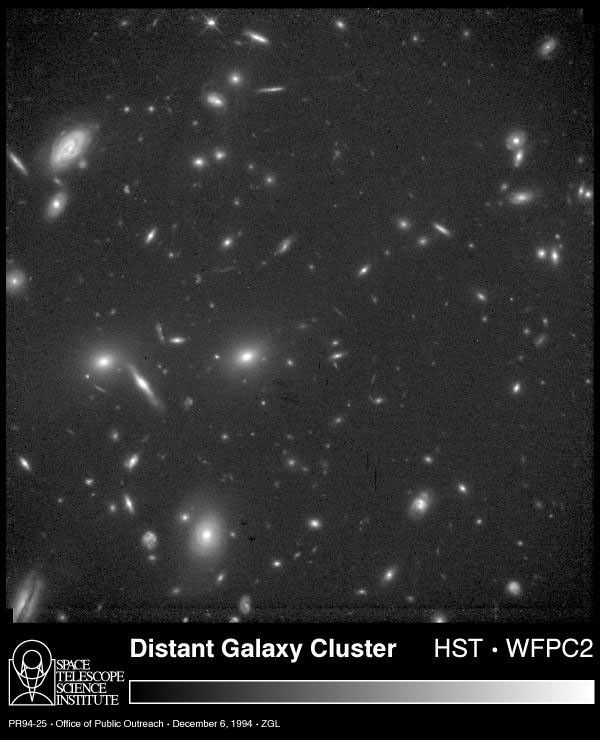1 min read
A Distant Cluster of Galaxies

[left] – One of the deepest images to date of the universe, taken with NASA's Hubble Space Telescope (HST), reveals thousands of faint galaxies at the detection limit of present day telescopes. Peering across a large volume of the observable cosmos, Hubble resolves thousands of galaxies from five to twelve billion light-years away. The light from these remote objects has taken billions of years to cross the expanding universe, making these distant galaxies fossil evidence" of events that happened when the universe was one-third its present age.
A fraction of the galaxies in this image belong to a cluster located nine billion light-years away. Though the field of view (at the cluster's distance) is only two million light-years across, it contains a multitude of fragmentary objects. (By comparison, the two million light-years between our Milky Way galaxy and its nearest large companion galaxy, in the constellation Andromeda, is essentially empty space!)
Very few of the cluster's members are recognizable as normal spiral galaxies (like our Milky Way), although some elongated members might be edge-on disks. Among this zoo of odd galaxies are ``tadpole-like'' objects, disturbed and apparently merging systems dubbed "train-wrecks," and a multitude of faint, tiny shards and fragments, dwarf galaxies or possibly an unknown population of objects. However, the cluster also contains red galaxies that resemble mature examples of today's elliptical galaxies. Their red color comes from older stars that must have formed shortly after the Big Bang.
The image is the full field view of the Wide Field and Planetary Camera-2. The picture was taken in intervals between May 11 and June 15, 1994 and required an 18-hour long exposure, over 32 orbits of HST, to reveal objects down to 29th magnitude.
[bottom right] – A close up view of the peculiar radio galaxy 3C324 used to locate the cluster. The galaxy is nine billion light-years away as measured by its spectral redshift (z=1.2), and located in the constellation Serpens. Based on the colors and the statistical distribution of the galaxies in 3C 324's vicinity, astronomers conclude a remote cluster is at the same distance as a radio galaxy.
[center right] – This pair of elliptical galaxies, seen together with a few fainter companions, is remarkably similar in shape, light distribution, and color to their present day descendants. This Hubble image provides evidence that ellipticals formed remarkably early in the universe.
[top right] – Some of the objects in this compact tangled group resemble today's spiral galaxies. However, they have irregular shapes and appear disrupted and asymmetric. This might be due to a high frequency of galaxy collisions and close encounters in the early universe.
About the Object
- R.A. PositionR.A. PositionRight ascension – analogous to longitude – is one component of an object's position.15h 49m 48.9s
- Dec. PositionDec. PositionDeclination – analogous to latitude – is one component of an object's position.21° 25' 37.99"
- Object NameObject NameA name or catalog number that astronomers use to identify an astronomical object.3C324
- Release DateDecember 6, 1994
- Science ReleaseHubble Identifies Primeval Galaxies, Uncovers New Clues to the Universe’s Evolution
- Credit
Related Images & Videos

Galaxies in the Young Universe
[left] – This image of a small region of the constellation Sculptor, taken with a ground-based photographic sky survey camera, illustrates the extremely small angular size of a distant galaxy cluster in the night sky. Though this picture encompasses a piece of the sky about the...

Galaxies: Snapshots in Time
This sequence of NASA Hubble Space Telescope (HST) images of remote galaxies offers tantalizing initial clues to the evolution of galaxies in the universe. [far left column] These are traditional spiral and elliptical-shaped galaxies that make up the two basic classes of...

Remote Galaxy Clusters: Lost Ancestors to Our Milky Way Galaxy
This NASA Hubble Space Telescope (HST) image of the central portion of a remote cluster of galaxies (CL 0939+4713) as it looked when the universe was two-thirds of its present age. Hubble's high resolution allows astronomers to study, for the first time, the shapes of galaxies...
Share
Details
Claire Andreoli
NASA’s Goddard Space Flight Center
Greenbelt, Maryland
claire.andreoli@nasa.gov















































